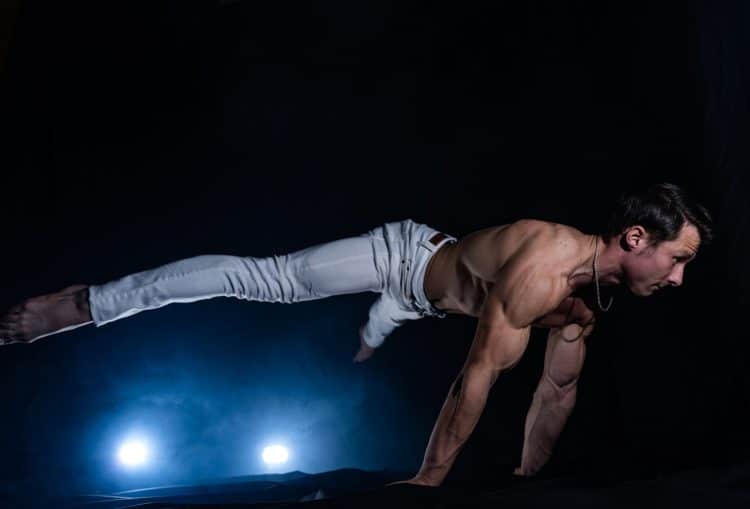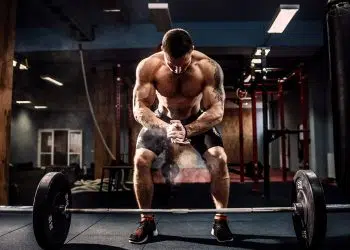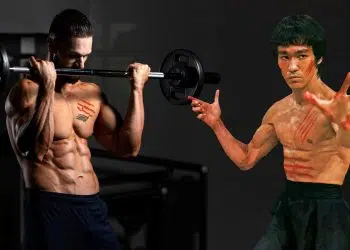Many exercisers skip doing push-ups as they feel they are too easy and do little to nothing for their strength or muscle gains. Most advanced lifters perform a few push-ups at the beginning of their chest or triceps workouts to warm up their target muscles. To be honest, you cannot blame them for this. Push-ups do get stagnant after a while.
Progressive overload is the name of the game when it comes to consistent strength and muscle gains. Progressive overload involves gradually increasing your training intensity to avoid hitting a plateau. New exercise variations are one of the best ways to challenge your muscles.
That said, there is only so much incline or decline push-ups can do. Plus, placing a weight plate on your back while doing push-ups is inconvenient and increases the risk of injury. You need a push-up variation that is challenging and doesn’t require a spotter to put a heavy weight plate on your back. Enter planche push-ups.
The evolution of calisthenics training is taking bodyweight exercises to the next level. Unlike the conventional push-ups that only stimulate your chest, arms, and shoulders, the planche push-ups are an advanced exercise that requires upper body, core, and leg engagement.
In this article, we dig deep into the planche push-up, its correct exercise form, muscles worked, benefits, common mistakes, and progression to help unlock new strength and muscle gains.
What is a Planche Push-Up?
Level Up Your Fitness: Join our 💪 strong community in Fitness Volt Newsletter. Get daily inspiration, expert-backed workouts, nutrition tips, the latest in strength sports, and the support you need to reach your goals. Subscribe for free!
While the conventional push-up involves placing your hands on the floor roughly under your shoulders, your hands are positioned under your hips in planche push-ups. Your hands will be the only touch point with the floor, and they should be in the center of your body to balance your weight.
Planche push-ups are excellent for folks looking for a new challenge. Remember, planche push-ups are a high-level gymnastics skill, and you need consistent practice to master this movement.
Once you have the planche push-ups, it’ll also make other gymnastics exercises like the L-sits, handstand walks, and front lever and back lever easier. Conversely, if you can perform any of these exercises, achieving the planche push-up will be easier for you than a gymnastics beginner.
How To Do a Planche Push-Up
This is how to perform the planche push-up with a picture-perfect form:
Step 1 — Get into Position
Lie on your belly on the floor with your arms extended at your sides. Your body should be in a straight line from head to toe. Place your hands on the sides of your hips. Turn your wrists so your hands are placed on the floor. Your fingers should point to your sides.
Pro Tip: instead of placing your fingers flat on the floor, curls your fingers slightly as if gripping the floor with your fingertips.
Step 2 — Brace Your Body
Contract your arms, chest, back, and legs. You should feel tight throughout your body. Extend your elbows so you are in a high push-up position.
Pro Tip: Think about resting your weight on your extended elbows. This cue should help you establish an equilibrium.
Step 3 — Lean Forward and Drive Your Hands Into the Floor
Once in the push-up position, take your time to find a solid base. Then, slowly shift your weight to your shoulders, chest, and upper arms. Take a deep breath and hold it. It will help you maintain your balance for the planche push-up.
Pro Tip: Avoid rushing through this step. Take as much time as you need to establish a solid base in this position.
Step 4 — Lift Your Legs
After your upper body is stable, contract your glutes, hamstrings, and quads, press your legs together, and slowly lift them off the floor. Your body should be in a straight line and parallel to the floor.
Pro Tip: Beginners should lift one leg off the floor at a time. This will help them balance their body. The extended position will vary for everyone. Some people hold their bodies in a straight line while others keep their lower bodies slightly above parallel.
Step 5 — Perform the Push-Ups
Find your balance in the push-up position. Slowly lower your body to the floor by bending your elbows. Your chest should be a few inches off the floor at the bottom of the range of motion. Keeping your elbows close to your sides will help you maintain your balance.
Pause for a second at the bottom of the range of motion. Return to the starting position by extending your elbows while breathing out.
Pro Tip: Keep your shoulder blades pulled back and down throughout the exercise for stability.
Planche Push-Up Tips:
- Keep your head neutral throughout the exercises. Tucking your chin into your upper chest or looking ahead can throw you off balance.
- Touch your toes to the floor if you lose your balance during the exercise. Take your feet off the floor as soon as you regain control.
- Beginners should practice this exercise with a cushion or exercise mat under their face. Losing balance while holding the isometric contracting at the top is quite common.
- Always keep your body in a straight line while performing this exercise. Flexing your hips will lead you to lose your balance and crash face-first into the floor.
- Focus on keeping the tension on the bottom of your triceps to maintain your equilibrium.
In This Exercise:
- Target Muscle Group: Chest
- Secondary Muscles: Triceps, Shoulders, Core, Glutes, Hamstrings, and Quads
- Type: Strength
- Mechanics: Compound
- Equipment: NA
- Difficulty: Advanced
- Best Rep Range: 1-5
Muscles Worked During Planche Push-Up
The planche push-up is a full-body exercise and engages the following muscle groups:
Triceps
Planche push-ups primarily involve elbow flexion and extension, leading to triceps stimulation. The more extensive your range of motion, the better your triceps pump will be. Keep your elbows close to your sides throughout the exercise for optimal triceps engagement.
Chest and Shoulders
Besides the elbows, this exercise also involves the shoulder joint, which results in pectoral and deltoid engagement. The planche push-ups will mainly lead to pectoralis major and anterior delt stimulation.
Level Up Your Fitness: Join our 💪 strong community in Fitness Volt Newsletter. Get daily inspiration, expert-backed workouts, nutrition tips, the latest in strength sports, and the support you need to reach your goals. Subscribe for free!
Abs
You must keep your core braced throughout the exercise to maintain your body in a straight line. Progression exercises like the crow and tucked push-ups are less ab-intensive than the straight body variations.
Lower Body
Holding your legs in a straight line requires you to contract your glutes, hamstrings, quads, and hip flexors. It’s not uncommon for exercisers to end up with a lower body pump after a few sets of planche push-ups.
Benefits of Planche Push-Up
Here are the advantages of adding the planche push-up to your training regimen:
Mind-Muscle Connection
Since you must keep your entire body braced throughout the exercise, the planche push-ups help you develop a robust mind-muscle connection. This mind-muscle connection carries over to other compound and isolation exercises.
Improves Balance
Holding your body in a straight line while doing the planche push-ups will help improve your balance. The additional demand on your core stabilizers will also improve your performance in daily tasks.
No Equipment
The planche push-ups require no equipment and can be done anywhere at any time. Unlike the conventional push-up, it is a full-body exercise that can be combined with any workout routine. That said, beginners can use parallettes, as it allows them more area to work through.
High-Skill Gymnastics Movement
Planche push-ups are a high-skill gymnastics movement that can unlock other exercises like handstand walks, pirouettes, and L-sits. The core strength developed in this exercise can also improve your muscle-ups and single-leg squats.
Common Mistakes While Performing Planche Push-Up
Avoid these errors to improve your training form and get the best out of your training session:
Hand Placement
Placing your hands too close to your chest or away from your body will throw you off balance. Your hands should be below your hips, and your fingers should point outward. That said, your exact hand placement might vary depending on your unique biomechanics. Experiment with different hand placements before arriving at your final pick.
Attempting the Plance Push-Up Too Soon
Although this guide is about the planche push-up, newbies shouldn’t expect to hit this exercise on their first try. However, you should anyway try the planche push-up to assess where you currently stand.
Focus on performing the planche push-up progression exercises to develop the core strength and skills required to execute a plance push-up. Give yourself anywhere between four to 12 weeks to hit your first planche push-up.
Leading With Your Shoulders
You must be able to hold the planche for at least 10 seconds before you try the planche push-up. Many exercisers make the mistake of leading with their shoulders while lowering toward the floor, throwing them off balance.
You must focus on lowering your body toward the floor in a straight line while bending your elbows. Keep your elbows close to your body and drive them behind your body.
Planche Push-Up Progression
“I was able to do planche push-ups on my first attempt,” said no one ever. Beginners must use the following exercises to build the requisite strength, mind-muscle connections, and balance for the planche push-ups:
Crow Pose
You must master the crow pose before you get to the much more complicated planche push-ups.
Steps:
- Begin in a squat position with your knees wide apart.
- Plant your hands on the floor in front of your feet and shoulder-width apart.
- Lift your heels off the floor and raise your hips toward the ceiling. Bring your knees toward your upper arms.
- Press your knees against your triceps.
- Lean forward slightly and transfer your weight onto your hands.
- Your elbows should stack over your wrists.
- Lift your heels toward your buttocks. Lift one foot off the floor at a time to balance yourself.
- Hold for as long as possible.
Tucked Planche
Once you’ve mastered the crow pose, it is time to move on to the tucked planche.
Steps:
- Begin in a squat position with your hands under your shoulders. Your feet should be under your hips at the starting position.
- Lean onto your hands to shift your center of gravity.
- Lift your feet off the floor while driving your knees between your arms and hold your heels against your hips.
- Hold the position for as long as possible.
Planche with One Leg
This exercise will take you one step closer to the full planche.
Steps:
- Get into the tucked planche position.
- While holding one leg against your chest, extend the other leg, so it is parallel to the floor.
- Hold for the desired time.
- Repeat on the other side.
Planche Straddle
Straddles are easier than holding your legs together in an isometric hold. You could also use parallettes for these exercises, as it will give your legs more room to work through.
Steps:
- Get into the tucked planche position.
- Keeping your core braced, extend your legs behind your body so it is in a straight line. Your feet should be at least shoulder-width apart.
- Beginners should try balancing their torso against their elbows in this exercise.
- Hold for as long as possible.
Planche Hold
After you’ve mastered the planche staddle, it’s time to bring your legs together. Get into the tucked planche position, and extend your legs behind you in one movement. Some people find extending one leg at a time more effective. Alternatively, you could transition to the planche hold from the planche straddle. Hold for the desired time.
Tucked Planche Push-Up
Going from planche hold to the planche push-up can be too much for most people. Instead, you should practice the push-ups in the tucked planche position. This will help you drill the movement and build the requisite core strength.
Planche Push-Up
Sticking to the tucked planche push-ups for a couple of weeks will give you enough confidence to move to the next step — the planche push-ups. Take it slow for the best result. Begin by performing one rep per set and make your way up to 10 reps per set.
Wrapping Up
Performing a push-up with your feet off the floor while keeping your body parallel to the floor might sound impossible, but consistent practice will get you there. It will take time, and you might fall flat on your face during the process, but the progression exercises will help get you to your final objective.
The planche push-up is probably the most difficult push-up variation. Mastering this exercise will also help you build a solid base for other high-skill gymnastics exercises like the handstand walks, L-sits, and front lever.
Interested in measuring your progress? Check out our strength standards for Push Ups, Muscle Ups, Decline Push Up, and more.












